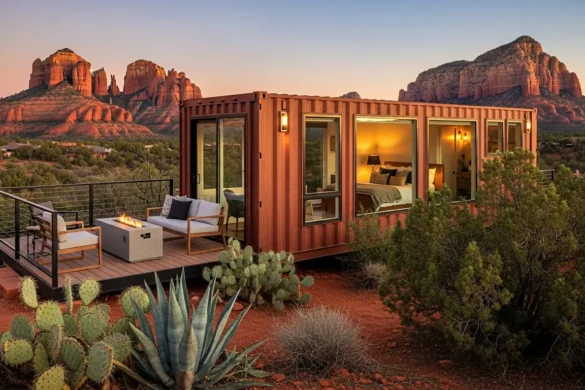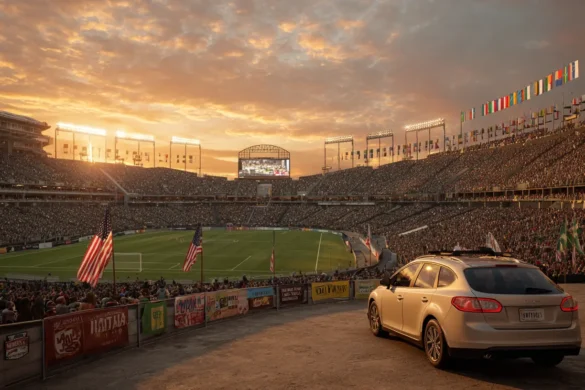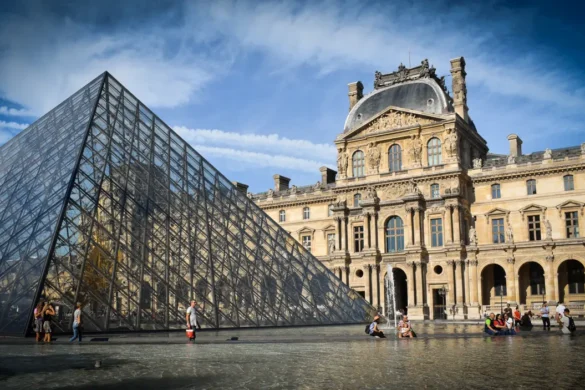Colorado has a way of getting under your skin. I’ve been here three times now, and each trip has pulled me deeper into its wild, high-altitude beauty. From glassy alpine lakes tucked between 14,000-foot peaks to wide, sunlit reservoirs rimmed by red rock, this state’s waters are as varied as its landscapes.
I’ve stood on the shores of Grand Lake, where the water mirrors the jagged skyline of the Rockies, and paddled across Blue Mesa Reservoir, its vast expanse glowing under a desert-blue sky. In the San Juan Mountains, I’ve hiked to hidden emerald pools that take your breath away…partly from the altitude, partly from the view. I’ve wandered past wildflower-framed waters in Crested Butte, watched golden aspens shimmer beside mountain reflections in the fall, and felt the quiet stillness of alpine tarns where the only sound is the wind. Every lake in this list is way more than just a pretty view. Here’s everything you need to know about visiting Colorado’s most scenic lakes.
Colorado’s Most Beautiful Lakes at a Glance
I’ve been to Colorado three times now, and I’ve personally visited every lake in this list. Each one has its own personality…from alpine gems hidden at 12,000 feet to massive reservoirs you can sail across. If you want the short version before diving into the details, here’s what I’ve learned:
- Best time to visit: July–September for warm weather and fully thawed alpine lakes. Early summer is amazing for wildflowers; late September for golden aspens.
- Top picks for hiking: Bear Lake (easy loop with big views), Lake Haiyaha (moderate trek through boulder fields), Ice Lake (challenging but spectacular).
- Easiest drive-up lakes: Grand Lake and Dillon Reservoir — both have towns right on the shore with plenty of food and lodging.
- Best for water sports: Blue Mesa Reservoir for boating and fishing, Horsetooth Reservoir for kayaking and paddleboarding.
- Most photographed: Maroon Lake with the Maroon Bells reflecting at sunrise — worth the early wake-up.
- Wildlife spotting: Sprague Lake for birdwatching, Cherry Creek Reservoir for waterfowl and the occasional deer.
- Permits to know about: Bear Lake and Maroon Lake require timed-entry reservations in peak season.
Colorado has over 4,000 lakes and reservoirs, but the ones in this guide are the ones I keep coming back to…because they combine natural beauty, accessibility, and experiences you’ll remember long after the trip.

1. Bear Lake
Bear Lake is basically the poster child for Rocky Mountain National Park, and honestly, it’s earned that reputation. The lake sits at 9,475 feet and reflects Hallett Peak and Flattop Mountain like a giant mirror when the wind isn’t blowing.
Here’s the deal with visiting in 2025: you absolutely need a timed-entry reservation from May 23 through October 19 if you want to visit between 5am and 6pm. The “Timed Entry + Bear Lake Road” permit costs $2 per vehicle (plus your park entrance fee) and you have to book it online at Recreation.gov. I learned this the hard way when I showed up without a reservation and got turned away. The permits go on sale May 1st at 8am for summer dates, and they sell out fast during peak season.
The Bear Lake Loop Trail is an easy 0.6-mile walk around the lake that’s actually wheelchair accessible. It’s perfect if you want those Instagram shots without breaking a sweat. But if you’re feeling more ambitious, this trailhead connects to some killer hikes like Emerald Lake, Dream Lake, and Lake Haiyaha. I did the Emerald Lake hike last September and it was absolutely worth the extra effort.
Park entrance fees are $30 for a 7-day vehicle pass or $70 for an annual Rocky Mountain National Park pass. The drive up Bear Lake Road is gorgeous, but parking fills up super early even with the reservation system. If you can’t get a permit, try arriving before 5am or after 6pm when reservations aren’t required – just be prepared for potential lines at the entrance.

2. Maroon Lake
Maroon Lake might be the most photographed lake in Colorado, and when you see those iconic Maroon Bells reflecting in the water at sunrise, you’ll understand why. The thing is, getting there in 2025 requires some serious planning.
From May 23 through October 19, you’ve got two options: take the RFTA shuttle ($16 for adults, $10 for seniors and kids 12 and under) or drive with a parking reservation ($10). I actually prefer the shuttle because driving means you have to arrive before 8am and leave by 4:30pm, plus the Aspen Highlands parking garage charges $8 per hour with a $48 weekend maximum. The shuttle runs every 15 minutes from the Maroon Bells Welcome Center at Aspen Highlands, and the ride takes about 15 minutes each way.
If you do drive up with a parking permit, the sunrise is absolutely spectacular. I got there at 6:30am last fall and had the place mostly to myself for about an hour before the shuttles started arriving. The Maroon Lake Trail is an easy 1.5-mile loop that’s perfect for families, and there are picnic tables if you want to hang out.
Pro tip: you can also bike up Maroon Creek Road for free anytime during shuttle season. It’s about 9 miles with 1,600 feet of elevation gain, but you’ll have the road mostly to yourself. Plus, there are three small campgrounds along the way (Silver Bell, Silver Queen, and Silver Bar) if you want to stay overnight and avoid the whole reservation mess.
- Read next: Jaw-Dropping Colorado Mountain Towns
- You may also like: Jaw-Dropping Colorado Destinations

3. Grand Lake
Grand Lake is Colorado’s largest and deepest natural lake, and it’s got this old-school mountain town vibe that makes it way more chill than some of the touristy spots. The lake sits right at the western entrance to Rocky Mountain National Park, which means you can boat in the morning and hike in the afternoon.
The Town of Grand Lake operates Headwaters Marina right downtown, and their boat rental setup is actually pretty solid. Pontoon boats range from $140-180 per hour depending on size (small ones seat 6, large ones seat 13), sport boats are $100 per hour, and kayaks are $30-40 per hour for 1-4 people. Everything’s first-come, first-serve – no reservations – which can be frustrating during busy weekends but works fine if you’re flexible. I went on a Tuesday in July and got a pontoon immediately.
The Grand Lake Marina also offers one-hour lake tours ($25 adults, $10 kids) at 10:30am, noon, and 2pm daily, plus sunset tours that are honestly pretty awesome. You’ll learn about the history while getting great views of Rocky Mountain National Park from the water. The marina staff told me they’ve seen moose swimming across the lake, which is apparently not that uncommon.
✈️ My #1 Hack for Cheap 2026 Flights:
It’s January, so flight prices are climbing fast—but you don't have to pay them. I’m currently seeing roundtrips to Europe for under $300 (deals you won’t find on Google Flights).
Step 1: Join Going.com's Free Plan here. It takes 10 seconds and requires no credit card.
Step 2: If you're doing a big trip this year, grab the 14-day free trial of Premium. You can even use my code JON25 for 25% off.
Seriously, this is the single best money-saving tool I’ve used in 8+ years.
👉 Send me cheap 2026 flightsFishing is solid year-round – the lake has rainbow trout, brown trout, brook trout, lake trout, and kokanee salmon. You’ll need a Colorado fishing license, and the best spots are supposedly around the islands and along the deeper drop-offs. There’s no entrance fee for the lake itself, just the boat rental costs and fishing licenses.
- Read next: Epic Winter Cabins in Colorado

4. Blue Mesa Reservoir
Blue Mesa Reservoir is absolutely massive – 20 miles long with 96 miles of shoreline – and it’s part of Curecanti National Recreation Area. This place is a serious boater’s paradise, especially if you’re into fishing or just want space to cruise without feeling crowded.
Elk Creek Marina has the best boat rental setup with pontoons, kayaks, and fishing boats. They’re located 16 miles west of Gunnison on Highway 50, and the staff actually knows what they’re talking about when it comes to fishing spots. Lake Fork Marina on the west end near Blue Mesa Dam is smaller but closer if you’re coming from the Montrose side.
Here’s what’s cool about Blue Mesa: there’s no entrance fee for the recreation area, but you need a boat launch permit. It’s $4 for 2 days, $10 for 14 days, or $30 for a full year. If you’re 62+ or have an Access pass, you get 50% off. All motorized boats need to be inspected for invasive mussels before launching, which takes about 5 minutes at any of the boat ramps.
The fishing is legitimately incredible. There’s an ongoing lake trout tournament (January 1 – April 30, 2025) with $10,000 in prizes where they want you to harvest smaller lake trout to keep the ecosystem balanced. Rainbow and brown trout average 14-16 inches, and the kokanee salmon runs are famous among Colorado anglers. I caught my limit of rainbows in about 3 hours last summer, and that’s not something I can say about many places.

5. Turquoise Lake
Turquoise Lake sits just west of Leadville at 9,869 feet elevation, and the name totally delivers – the water really is this incredible turquoise color that changes throughout the day. It’s way less crowded than the famous spots but still has solid amenities.
The US Forest Service manages this one, so there’s no entrance fee, just day-use fees for some of the developed areas. The lake has multiple campgrounds (Turquoise Lake, Baby Doe, Silver Dollar, Belle of Colorado) that are perfect if you want to wake up right on the water. I stayed at Belle of Colorado last August and could literally fish from my campsite.
The Turquoise Lake Trail goes all the way around the lake (about 6.5 miles) and connects to tons of other trails heading up toward Mount Massive and Mount Elbert. The trail is mostly flat and great for mountain biking too. What I love about this place is you can easily combine water activities with serious hiking – Mount Elbert (Colorado’s highest peak) is right there if you want to bag a fourteener.
Fishing is solid for rainbow, brown, and cutthroat trout. The best spots are around the inlet areas and along the dam. Boat launches are available, but honestly, this lake is perfect for kayaking or paddleboarding since it’s usually pretty calm. The views of Mount Massive and Mount Elbert from the water are absolutely killer, especially during aspens season in late September.

6. Crystal Reservoir
Crystal Reservoir in the Pikes Peak region doesn’t get nearly the attention it deserves, and that’s honestly fine by me. It sits at about 9,200 feet and offers this perfect combo of fishing, easy hiking, and incredible mountain views without the crowds you’ll find at more famous spots.
The reservoir is managed by Colorado Springs Utilities, and there’s no entrance fee – just show up and enjoy. The Crystal Reservoir Trail is an easy 2-mile loop that’s perfect for families or if you just want a chill walk with mountain views. The trail connects to longer hikes heading toward Pikes Peak if you’re feeling ambitious.
Fishing is the main draw here, with rainbow and brown trout that are surprisingly feisty for a smaller reservoir. I’ve had good luck fishing from the shore, especially around the inlet and outlet areas. The water stays pretty cold year-round, so it’s not great for swimming, but it’s perfect for kayaking or a small fishing boat.
What makes Crystal Reservoir special is the Pikes Peak views. On clear days, you can see the entire Front Range, and the reflection shots are incredible if you’re into photography. It’s also way less windy than some of the bigger lakes, which makes it perfect for stand-up paddleboarding. The drive up Crystal Reservoir Road is beautiful too, especially during aspen season.

7. Dillon Reservoir
Dillon Reservoir is basically Summit County’s playground, and with the towns of Dillon and Frisco right on the shore, you’ve got tons of options for food, lodging, and gear rentals. The reservoir sits at 9,017 feet and offers some of the best sailing in Colorado.
Frisco Bay Marina and Dillon Marina both have full-service boat rentals including sailboats, pontoons, kayaks, and paddleboards. Pontoon rentals run about $150-200 per hour, and they often have multi-hour discounts. What’s cool is you can sail from one marina to the other and grab lunch in either Frisco or Dillon. I did this last summer and it was perfect – sailed from Frisco to Dillon, had lunch at Peppino’s Ristorante, then sailed back.
The Dillon Reservoir Trail is a 7.5-mile paved path that goes all the way around the lake. It’s perfect for biking, walking, or just cruising on an e-bike while taking in the Tenmile Range views. The trail connects both towns and has multiple access points, so you can easily do shorter sections.
Fishing is solid year-round with brown trout, rainbow trout, and kokanee salmon. Ice fishing is popular in winter, and the Dillon Marina actually rents ice fishing gear. The best part about Dillon Reservoir is the convenience – you can boat all day, then walk to dinner and craft beer without moving your car. The Frisco side tends to be a bit less crowded than Dillon.
- Read next: Best Winter Places to Visit in Colorado

8. Hanging Lake
Hanging Lake is honestly one of the most unique places in Colorado, but getting there requires serious advance planning. This isn’t just a casual “let’s check it out” kind of place – you need permits, and they sell out fast.
As of 2025, permits cost $12 per person in summer ($10 in winter) and you must book them online at visitglenwood.com. Reservations opened March 17, 2025 for the summer season, and the trail reopened July 1 after major reconstruction. You get a 3-hour window to complete the hike, and you must arrive within 30 minutes of your reservation time or you won’t be allowed in. No exceptions.
The hike is 1.2 miles each way with 1,200 feet of elevation gain, and it’s way harder than it looks on Instagram. The trail is basically rock steps and switchbacks the entire way up, and the altitude can really hit you if you’re not used to it. I’m in decent shape and it took me about 90 minutes to get up and 45 minutes down, with several breaks. Bring water and wear actual hiking shoes – not sneakers or flip-flops.
What makes Hanging Lake incredible is the turquoise water and Bridal Veil Falls feeding into it. The color comes from dissolved limestone, and swimming or touching the water is absolutely prohibited because the ecosystem is super fragile. Spouting Rock is another 200 feet above the lake if you want to keep going – water literally shoots out of a hole in the cliff face. The whole thing feels like you’re in a fairy tale, which is why people put up with all the permit hassle.

9. Sprague Lake
Sprague Lake in Rocky Mountain National Park is perfect if you want stunning mountain views without the crowds at Bear Lake. At 8,710 feet elevation, it’s one of the more accessible alpine lakes and offers incredible Continental Divide views.
The same timed-entry requirements apply here as Bear Lake – you need that $2 “Timed Entry + Bear Lake Road” permit from May 23-October 19 if visiting between 5am-6pm. But here’s the thing: Sprague Lake gets way less traffic than Bear Lake, so you can actually enjoy some peace and quiet.
The Sprague Lake Trail is only 0.5 miles and completely wheelchair accessible. It’s basically a nature walk around the lake with incredible views of Hallett Peak, Flattop Mountain, and Thatchtop Mountain. This is hands down the best spot in the park for wildlife watching – I’ve seen moose, elk, and tons of birds here. The marshy areas around the lake are perfect habitat, especially early morning and evening.
Fishing is solid for brook and rainbow trout, and the shallow areas warm up enough for decent fishing by mid-summer. What I love about Sprague Lake is it’s perfect for families with young kids or anyone who wants that Rocky Mountain National Park experience without dealing with crowds or difficult hikes. The reflection shots of the Continental Divide are incredible, especially during sunrise when most people are still sleeping.
- Read my guide: The Most Fun Things to Do in Colorado in 2025

10. Lake Haiyaha
Lake Haiyaha (pronounced “hi-YAH-ha”) is one of Rocky Mountain National Park’s hidden gems, and the name means “big rocks” in Arapaho – which makes perfect sense when you see the massive boulder field surrounding the lake.
You’ll need the same timed-entry permits as the other Bear Lake Road destinations, but the payoff is worth it. The trail to Lake Haiyaha is 2.2 miles each way from Bear Lake and gains about 650 feet of elevation. It’s considered moderate, but those last 0.5 miles through the boulder field can be tricky – you’re basically hopping from rock to rock.
I hiked this in early September and had the lake almost entirely to myself. The water is this incredible deep blue-green color, and it’s surrounded by these huge granite boulders that look like giants dropped them there. The lake sits at 10,220 feet, so the water is freezing year-round, but the setting is absolutely magical.
Fishing can be good for brook and cutthroat trout, especially in the deeper areas near the outlet. The boulders make great perches for fishing, and the lake is deep enough that fish can survive the harsh winters. What makes Lake Haiyaha special is the solitude – while Bear Lake and Emerald Lake get packed, this place feels wild and remote. The boulder scrambling keeps casual visitors away, so you get that backcountry feeling without actually going into the backcountry.

11. Horsetooth Reservoir
Horsetooth Reservoir just west of Fort Collins is a local favorite that doesn’t get much tourist attention, which honestly keeps it pretty awesome for those of us who know about it. The reservoir is 6.5 miles long and sits right up against Horsetooth Mountain, creating this dramatic backdrop.
Larimer County manages the reservoir, and day-use fees are $9 per vehicle. There are multiple boat ramps, and the water is perfect for wakeboarding, water skiing, and sailing. Inlet Bay Marina has boat rentals including pontoons, ski boats, and personal watercraft. The reservoir gets busy on summer weekends, but weekdays are usually pretty mellow.
The Horsetooth Reservoir Trail system has over 15 miles of hiking and mountain biking trails with killer views of the Front Range and the reservoir. Horsetooth Falls is a popular 3-mile round-trip hike that’s especially cool in spring when snowmelt gets the waterfall pumping. The Arthur’s Rock Trail is more challenging but offers incredible 360-degree views.
Camping is available at several campgrounds around the reservoir, and they’re way more affordable than the touristy mountain spots. I love Inlet Bay Campground because you can literally launch your kayak from your campsite. Fishing is solid for walleye, bass, rainbow trout, and brown trout. The reservoir has several coves and inlets that are perfect for exploring by kayak or paddleboard.

12. Cherry Creek Reservoir
Cherry Creek Reservoir sits right in the Denver metro area in Cherry Creek State Park, and it’s honestly a great option if you want water recreation without driving into the mountains. The 880-acre reservoir offers surprising variety for being so close to the city.
Colorado State Parks manages this one, so you’ll pay the standard daily vehicle fee ($10) or get a annual parks pass ($80). The reservoir allows pretty much every water activity you can think of – sailing, windsurfing, waterskiing, jet skiing, fishing, and swimming. Cherry Creek Marina has boat rentals including pontoons, fishing boats, and personal watercraft.
The park has 35 miles of trails that are perfect for hiking, biking, and horseback riding. The Cherry Creek Trail connects to the larger Denver trail system, so you can actually bike here from downtown if you’re feeling ambitious. Wildlife watching is surprisingly good – the wetland areas attract tons of birds, and you’ll often see deer, especially early morning and evening.
Fishing is solid year-round with walleye, bass, rainbow trout, catfish, and yellow perch. Ice fishing is popular in winter when the reservoir freezes. What I appreciate about Cherry Creek is the convenience – you can have a full day on the water and still be back in Denver for dinner. The swimming beach is actually pretty nice too, with lifeguards during summer months and a designated swimming area that’s separate from the boat traffic.
- Read also: My Favorite Places to Stay in Colorado
- You may also like: Amazing Spa Hotels Near Denver



Global Viewpoint is a personal blog. All content is for informational and entertainment purposes only and does not constitute professional financial, medical, or legal advice.





